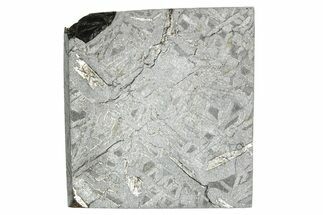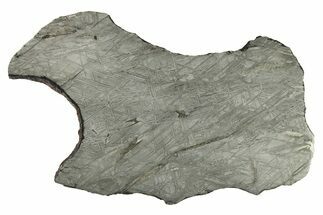This Specimen has been sold.
2.39" Etched Iron Meteorite (77.2 g) Slice - NWA 11289
This is a 2.39" wide (77.2 gram) slice of the iron meteorite, NWA 11289. It has been etched to reveal the intriguing, internal crystalline patterns and sealed.
About NWA 11289
NWA 11289 is a III AB type iron meteorite that was discovered in 2012 when it was purchased from a dealer in Temara, Morocco. The total known weight of this meteorite fall is only 4.6kg. When cut and etched this meteorite reveals beautiful geometric Widmanstätten patterns in its interior, characteristic of iron octahedrite meteorites. These patterns are created when asteroid cores cool slowly in the vacuum of space, crystallizing the various nickel and iron alloys to crystallized into intermixed millimeter-sized bands. Widmanstätten patterns of the sizes seen in iron meteorites can only be created in slow cooling over millions of years, which cannot occur on Earth: therefore, Widmanstätten patterns visible to the naked eye are a sure sign of a meteorite!
Meteoritical Bulletin: Entry for the NWA 11289 Meteorite
NWA 11289 is a III AB type iron meteorite that was discovered in 2012 when it was purchased from a dealer in Temara, Morocco. The total known weight of this meteorite fall is only 4.6kg. When cut and etched this meteorite reveals beautiful geometric Widmanstätten patterns in its interior, characteristic of iron octahedrite meteorites. These patterns are created when asteroid cores cool slowly in the vacuum of space, crystallizing the various nickel and iron alloys to crystallized into intermixed millimeter-sized bands. Widmanstätten patterns of the sizes seen in iron meteorites can only be created in slow cooling over millions of years, which cannot occur on Earth: therefore, Widmanstätten patterns visible to the naked eye are a sure sign of a meteorite!
Meteoritical Bulletin: Entry for the NWA 11289 Meteorite
About Iron Meteorites
Iron type meteorites are composed primarily of iron and nickel, and are the remnants of differential cores torn apart at the beginning of the solar system. These metallic meteorites are often the easiest to identify after millions of years post-impact because they are quite different from terrestrial material, especially when it comes to their mass-to-surface area ratio. They are exceptionally heavy for their size since iron is a high-density metal: this is also why the Earth's core is nickel-iron. As planets form, the densest metals form gravitational centers, bringing more and more material into their gravitational pull. In the solar system's rocky planets, these dense materials are most often nickel and iron.
Most iron meteorites have distinctive, geometric patterns called Widmanstätten patterns, which become visible when the meteorite is cut and acid etched. These patterns are criss-crossing bands of the iron-nickel alloys kamacite and taenite that slowly crystalized as the core of the meteorites' parent bodies slowly cooled. Such large alloy crystallizations for mover millions of years and do not occur naturally on Earth, further proving that iron meteorites come from extraterrestrial bodies.
Iron type meteorites are composed primarily of iron and nickel, and are the remnants of differential cores torn apart at the beginning of the solar system. These metallic meteorites are often the easiest to identify after millions of years post-impact because they are quite different from terrestrial material, especially when it comes to their mass-to-surface area ratio. They are exceptionally heavy for their size since iron is a high-density metal: this is also why the Earth's core is nickel-iron. As planets form, the densest metals form gravitational centers, bringing more and more material into their gravitational pull. In the solar system's rocky planets, these dense materials are most often nickel and iron.
Most iron meteorites have distinctive, geometric patterns called Widmanstätten patterns, which become visible when the meteorite is cut and acid etched. These patterns are criss-crossing bands of the iron-nickel alloys kamacite and taenite that slowly crystalized as the core of the meteorites' parent bodies slowly cooled. Such large alloy crystallizations for mover millions of years and do not occur naturally on Earth, further proving that iron meteorites come from extraterrestrial bodies.
TYPE
Iron (IIIAB)
LOCATION
Morocco
SIZE
2.39 x 2.09", .2" thick, Weight: 77.2 grams
CATEGORY
ITEM
#263659
 Reviews
Reviews












